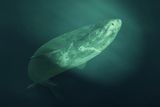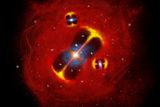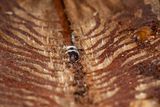Vue lecture
Fresh conflicts erupt around giant database for flu and COVID-19 sequences
NASA works to extend Swift’s life ahead of reboost mission

As preparations continue for a mission to raise the orbit of NASA’s Swift astrophysics spacecraft, project officials are also pursuing steps to extend the satellite’s life in case of delays.
The post NASA works to extend Swift’s life ahead of reboost mission appeared first on SpaceNews.
How a 400-Year-Old Shark Keeps Its Vision From Breaking Down

Betelgeuse's Brightness Wavers Due to a Companion Star and Its Swirling Trail of Gas

Appeals court agrees that NIH cannot reduce overhead payments to academic institutions
Exclusive: Have scientists found Leonardo da Vinci’s DNA?
Against all odds, a curious sea creature survived the dino-killing asteroid
What People Who Lived Past 110 in Brazil Reveal About Health Span — Not Lifespan

Rare and Elusive CookieCutter Shark Leaves a Round Wound in Its Prey


Ancient Teeth Record Climate Change and Medieval Migration Into England

Willy Ley’s Long-Awaited Journey to Orbit: Honoring a Space Pioneer on Celestis’ Serenity and Destiny Flights

HOUSTON, TX January 6, 2025 – For nearly a century, humanity’s vision of spaceflight has been shaped not only by engineers and astronauts, but by those who dared to imagine […]
The post Willy Ley’s Long-Awaited Journey to Orbit: Honoring a Space Pioneer on Celestis’ Serenity and Destiny Flights appeared first on SpaceNews.
Orbiter Observes Sun's Hot Spots for Record-Breaking 94 Days, Enhancing Solar Storm Forecasts

Space cyber compliance: managing requirements for today and tomorrow

Space operators face a complex and evolving cybersecurity regulatory challenge. While the importance of cybersecurity in today’s digital world is widely recognized, international approaches remain inconsistent. Long-term global compliance requirements are still unclear. With new regimes emerging across multiple jurisdictions, the cybersecurity landscape continues to shift, posing a challenge that space operators must address now, […]
The post Space cyber compliance: managing requirements for today and tomorrow appeared first on SpaceNews.
Jellyfish sleep a lot like us—and for the same reasons
New hybrid state of matter is a mix of solid and liquid
The boundary between a substance’s liquid and solid phases may not be as clear-cut as previously believed. A new state of matter that is a hybrid of both has emerged in research by scientists at the University of Nottingham, UK and the University of Ulm, Germany, and they say the discovery could have applications in catalysis and other thermally-activated processes.
In liquids, atoms move rapidly, sliding over and around each other in a random fashion. In solids, they are fixed in place. The transition between the two states, solidification, occurs when random atomic motion transitions to an ordered crystalline structure.
At least, that’s what we thought. Thanks to a specialist microscopy technique, researchers led by Nottingham’s Andrei Khlobystov found that this simple picture isn’t entirely accurate. In fact, liquid metal nanoparticles can contain stationary atoms – and as the liquid cools, their number and position play a significant role in solidification.
Some atoms remain stationary
The team used a method called spherical and chromatic aberration-corrected high-resolution transmission electron microscopy (Cc/Cs-corrected HRTEM) at the low-voltage SALVE instrument at Ulm to study melted metal nanoparticles (such as platinum, gold and palladium) deposited on an atomically thin layer of graphene. This carbon-based material acted a sort of “hob” for heating the particles, says team member Christopher Leist, who was in charge of the HRTEM experiments. “As they melted, the atoms in the nanoparticles began to move rapidly, as expected,” Leist says. “To our surprise, however, we found that some atoms remained stationary.”
At high temperatures, these static atoms bind strongly to point defects in the graphene support. When the researchers used the electron beam from the transmission microscope to increase the number of these defects, the number of stationary atoms within the liquid increased, too. Khlobystov says that this had a knock-on effect on how the liquid solidified: when the stationary atoms are few in number, a crystal forms directly from the liquid and continues to grow until the entire particle has solidified. When their numbers increase, the crystallization process cannot take place and no crystals form.
“The effect is particularly striking when stationary atoms create a ring (corral) that surrounds and confines the liquid,” he says. “In this unique state, the atoms within the liquid droplet are in motion, while the atoms forming the corral remain motionless, even at temperatures well below the freezing point of the liquid.”
Unprecedented level of detail
The researchers chose to use Cc/Cs-corrected HRTEM in their study because minimizing spherical and chromatic aberrations through specialized hardware installed on the microscope enabled them to resolve single atoms in their images.
“Additionally, we can control both the energy of the electron beam and the sample temperature (the latter using MEMS-heated chip technology),” Khlobystov explains. “As a result, we can study metal samples at temperatures of up to 800 °C, even in a molten state, without sacrificing atomic resolution. We can therefore observe atomic behaviour during crystallization while actively manipulating the environment around the metal particles using the electron beam or by cooling the particles. This level of detail under such extreme conditions is unprecedented.”
Effect could be harnessed for catalysis
The Nottingham-Ulm researchers, who report their work in ACS Nano, say they obtained their results by chance while working on an EPSRC-funded project on 1-2 nm metal particles for catalysis applications. “Our approach involves assembling catalysts from individual metal atoms, utilizing on-surface phenomena to control their assembly and dynamics,” explains Khlobystov. “To gain this control, we needed to investigate the behaviour of metal atoms at varying temperatures and within different local environments on a support material.
“We suspected that the interplay between vacancy defects in the support and the sample temperature creates a powerful mechanism for controlling the size and structure of the metal particles,” he tells Physics World. “Indeed, this study revealed the fundamental mechanisms behind this process with atomic precision.”
The experiments were far from easy, he recalls, with one of the key challenges being to identify a thin, robust and thermally conductive support material for the metal. Happily, graphene meets all these criteria.
“Another significant hurdle to overcome was to be able to control the number of defect sites surrounding each particle,” he adds. “We successfully accomplished this by using the TEM’s electron beam not just as an imaging tool, but also as a means to modify the environment around the particles by creating defects.”
The researchers say they would now like to explore whether the effect can be harnessed for catalysis. To do this, Khlobystov says it will be essential to improve control over defect production and its scale. “We also want to image the corralled particles in a gas environment to understand how the phenomenon is influenced by reaction conditions, since our present measurements were conducted in a vacuum,” he adds.
The post New hybrid state of matter is a mix of solid and liquid appeared first on Physics World.
Is the race for moon missions lunacy?

Even as NASA prepares for its Artemis 2 moon-circling mission, an Artemis 3 lunar-landing mission has suffered multiple delays, with no assurance of a launch before 2030. That may be a good thing because NASA still has not overcome critical risks and technological gaps of lunar exploration. These problems must be solved before we can establish a safe, productive long-term human […]
The post Is the race for moon missions lunacy? appeared first on SpaceNews.
A theoretical physicist’s journey through the food and drink industry
Rob Farr is a theorist and computer modeller whose career has taken him down an unconventional path. He studied physics at the University of Cambridge, UK, from 1991 to 1994, staying on to do a PhD in statistical physics. But while many of his contemporaries then went into traditional research fields – such as quantum science, high-energy physics and photonic technologies – Farr got a taste for the food and drink manufacturing industry. It’s a multidisciplinary field in which Farr has worked for more than 25 years.
After leaving academia in 1998, first stop was Unilever’s €13bn foods division. For two decades, latterly as a senior scientist, Farr guided R&D teams working across diverse lines of enquiry – “doing the science, doing the modelling”, as he puts it. Along the way, Farr worked on all manner of consumer products including ice-cream, margarine and non-dairy spreads, as well as “dry” goods such as bouillon cubes. There was also the occasional foray into cosmetics, skin creams and other non-food products.
As a theoretical physicist working in industrial-scale food production, Farr’s focus has always been on the materials science of the end-product and how it gets processed along the way. “Put simply,” says Farr, “that means making production as efficient as possible – regarding both energy and materials use – while developing ‘new customer experiences’ in terms of food taste, texture and appearance.”
Ice-cream physics
One tasty multiphysics problem that preoccupied Farr for a good chunk of his time at Unilever is ice cream. It is a hugely complex material that Farr likens to a high-temperature ceramic, in the sense that the crystalline part of it is stored very near to the melting point of ice. “Equally, the non-ice phase contains fats,” he says, “so there’s all sorts of emulsion physics and surface science to take into consideration.”
Ice cream also has polymers in the mix, so theoretical modelling needs to incorporate the complex physics of polymer–polymer phase separation as well as polymer flow, or “rheology”, which contributes to the product’s texture and material properties. “Air is another significant component of ice cream,” adds Farr, “which means it’s a foam as well as an emulsion.”
As well as trying to understand how all these subcomponents interact, there’s also the thorny issue of storage. After it’s produced, ice cream is typically kept at low temperatures of about –25 °C – first in the factory, then in transit and finally in a supermarket freezer. But once that tub of salted-caramel or mint choc chip reaches a consumer’s home, it’s likely to be popped in the ice compartment of a fridge freezer at a much milder –6 or –7 °C.
Manufacturers therefore need to control how those temperature transitions affect the recrystallization of ice. This unwanted outcome can lead to phenomena like “sintering” (which makes a harder product) and “ripening” (which can lead to big ice crystals that can be detected in the mouth and detract from the creamy texture).
“Basically, the whole panoply of soft-matter physics comes into play across the production, transport and storage of ice cream,” says Farr. “Figuring out what sort of materials systems will lead to better storage stability or a more consistent product texture are non-trivial questions given that the global market for ice cream is worth in excess of €100bn annually.”
A shot of coffee?
After almost 20 years working at Unilever, in 2017 Farr took up a role as coffee science expert at JDE Peet’s, the Dutch multinational coffee and tea company. Switching from the chilly depths of ice cream science to the dark arts of coffee production and brewing might seem like a steep career phase change, but the physics of the former provides a solid bridge to the latter.
The overlap is evident, for example, in how instant coffee gets freeze-dried – a low-temperature dehydration process that manufacturers use to extend the shelf-life of perishable materials and make them easier to transport. In the case of coffee, freeze drying (or lyophilization, as it’s commonly known) also helps to retain flavour and aromas.
If you want to study a parameter space that’s not been explored before, the only way to do that is to simulate the core processes using fundamental physics
After roasting and grinding the raw coffee beans, manufacturers extract a coffee concentrate using high pressure and water. This extract is then frozen, ground up and placed in a vacuum well below 0 °C. A small amount of heat is applied to sublime the ice away and remove the remaining water from the non-ice phase.
The quality of the resulting freeze-dried instant coffee is better than ordinary instant coffee. However, freeze-drying is also a complex and expensive process, which manufacturers seek to fine-tune by implementing statistical methods to optimize, for example, the amount of energy consumed during production.
Such approaches involve interpolating the gaps between existing experimental data sets, which is where a physics mind-set comes in. “If you want to study a parameter space that’s not been explored before,” says Farr, “the only way to do that is to simulate the core processes using fundamental physics.”
Beyond the production line, Farr has also sought to make coffee more stable when it’s stored at home. Sustainability is the big driver here: JDE Peet’s has committed to make all its packaging compostable, recyclable or reusable by 2030. “Shelf-life prediction has been a big part of this R&D initiative,” he explains. “The work entails using materials science and the physics of mass transfer to develop next-generation packaging and container systems.”
Line of sight
After eight years unpacking the secrets of coffee physics at JDE Peet’s, Farr was given the option to relocate to the Netherlands in mid-2025 as part of a wider reorganization of the manufacturer’s corporate R&D function. However, he decided to stay put in Oxford and is now deciding between another role in the food manufacturing sector, or moving into a new area of research, such as nuclear energy, or even education.

Farr believes he gained a lot from his time at JDE Peet’s. As well as studying a wide range of physics problems, he also benefited from the company’s rigorous approach to R&D, whereby projects are regularly assessed for profitability and quickly killed off if they don’t make the cut. Such prioritization avoids wasted effort and investment, but it also demands agility from staff scientists, who have to build long-term research strategies against a project landscape in constant flux.
A senior scientist needs to be someone who colleagues come to informally to discuss their technical challenges.
To thrive in that setting, Farr says collaboration and an open mind are essential. “A senior scientist needs to be someone who colleagues come to informally to discuss their technical challenges,” he says. “You can then find the scientific question which underpins seemingly disparate problems and work with colleagues to deliver commercially useful solutions.” For Farr, it’s a self-reinforcing dynamic. “As more people come to you, the more helpful you become – and I love that way of working.”
What Farr calls “line-of-sight” is another unique feature of industrial R&D in food materials. “Maybe you’re only building one span of a really long bridge,” he notes, “but when you can see the process end-to-end, as well as your part in in it, that is a fantastic motivator.” Indeed, Farr believes that for physicists who want a job doing something useful, the physics of food materials makes a great career. “There are,” he concludes, “no end of intriguing and challenging research questions.”
The post A theoretical physicist’s journey through the food and drink industry appeared first on Physics World.
Quantum photonics network passes a scaling-up milestone
Physicists in the UK have succeeded in routing and teleporting entangled states of light between two four-user quantum networks – an important milestone in the development of scalable quantum communications. Led by Mehul Malik and Natalia Herrera Valencia of Heriot-Watt University in Edinburgh, Scotland, the team achieved this milestone thanks to a new method that uses light-scattering processes in an ordinary optical fibre to program a circuit. This approach, which is radically different from conventional methods based on photonic chips, allows the circuit to function as a programmable entanglement router that can implement several different network configurations on demand.
The team performed the experiments using commercially-available optical fibres, which are multi-mode structures that scatter light via random linear optical processes. In simple terms, Herrera Valencia explains that this means the light tends to ricochet chaotically through the fibres along hundreds of internal pathways. While this effect can scramble entanglement, researchers at the Institut Langevin in Paris, France had previously found that the scrambling can be calculated by analysing how the fibre transmits light. What is more, the light-scattering processes in such a medium can be harnessed to make programmable optical circuits – which is exactly what Malik, Herrera Valencia and colleagues did.
“Top-down” approach
The researchers explain that this “top-down” approach simplifies the circuit’s architecture because it separates the layer where the light is controlled from the layer in which it is mixed. Using waveguides for transporting and manipulating the quantum states of light also reduces optical losses. The result is a reconfigurable multi-port device that can distribute quantum entanglement between many users simultaneously in multiple patterns, switching between different channels (local connections, global connections or both) as required.
A further benefit is that the channels can be multiplexed, allowing many quantum processors to access the system at the same time. The researchers say this is similar to multiplexing in classical telecommunications networks, which makes it possible to send huge amounts of data through a single optical fibre using different wavelengths of light.
Access to a large number of modes
Although controlling and distributing entangled states of light is key for quantum networks, Malik says it comes with several challenges. One of these is that conventional methods based on photonics chips cannot be scaled up easily. They are also very sensitive to imperfections in how they’re made. In contrast, the waveguide-based approach developed by the Heriot-Watt team “opens up access to a large number of modes, providing significant improvements in terms of achievable circuit size, quality and loss,” Malik tells Physics World, adding that the approach also fits naturally with existing optical fibre infrastructures.
Gaining control over the complex scattering process inside a waveguide was not easy, though. “The main challenge was the learning curve and understanding how to control quantum states of light inside such a complex medium,” Herrera Valencia recalls. “It took time and iteration, but we now have the precise and reconfigurable control required for reliable entanglement distribution, and even more so for entanglement swapping, which is essential for scalable networks.”
While the Heriot-Watt team used the technique to demonstrate flexible quantum networking, Malik and Herrera Valencia say it might also be used for implementing large-scale photonic circuits. Such circuits could have many applications, ranging from machine learning to quantum computing and networking, they add.
Looking ahead, the researchers, who report their work in Nature Photonics, say they are now aiming to explore larger-scale circuits that can operate on more photons and light modes. “We would also like to take some of our network technology out of the laboratory and into the real world,” says Malik, adding that Herrera Valencia is leading a commercialization effort in that direction.
The post Quantum photonics network passes a scaling-up milestone appeared first on Physics World.
Congress set to reject Trump’s major budget cuts to NSF, NASA, and energy science
Procrastination, Perfectionism, and Self-blame are Modern Symptoms of Primeval Survival Instincts

Astronomers Looked Back 12 Billion Years, and Found a Galaxy Cluster That Defies Theory

Fatal Fungus Turns Beetles’ Chemical Shields Into a Deadly Weakness

A Rogue Planet the Size of Saturn Detected 10,000 Light-Years From Earth
